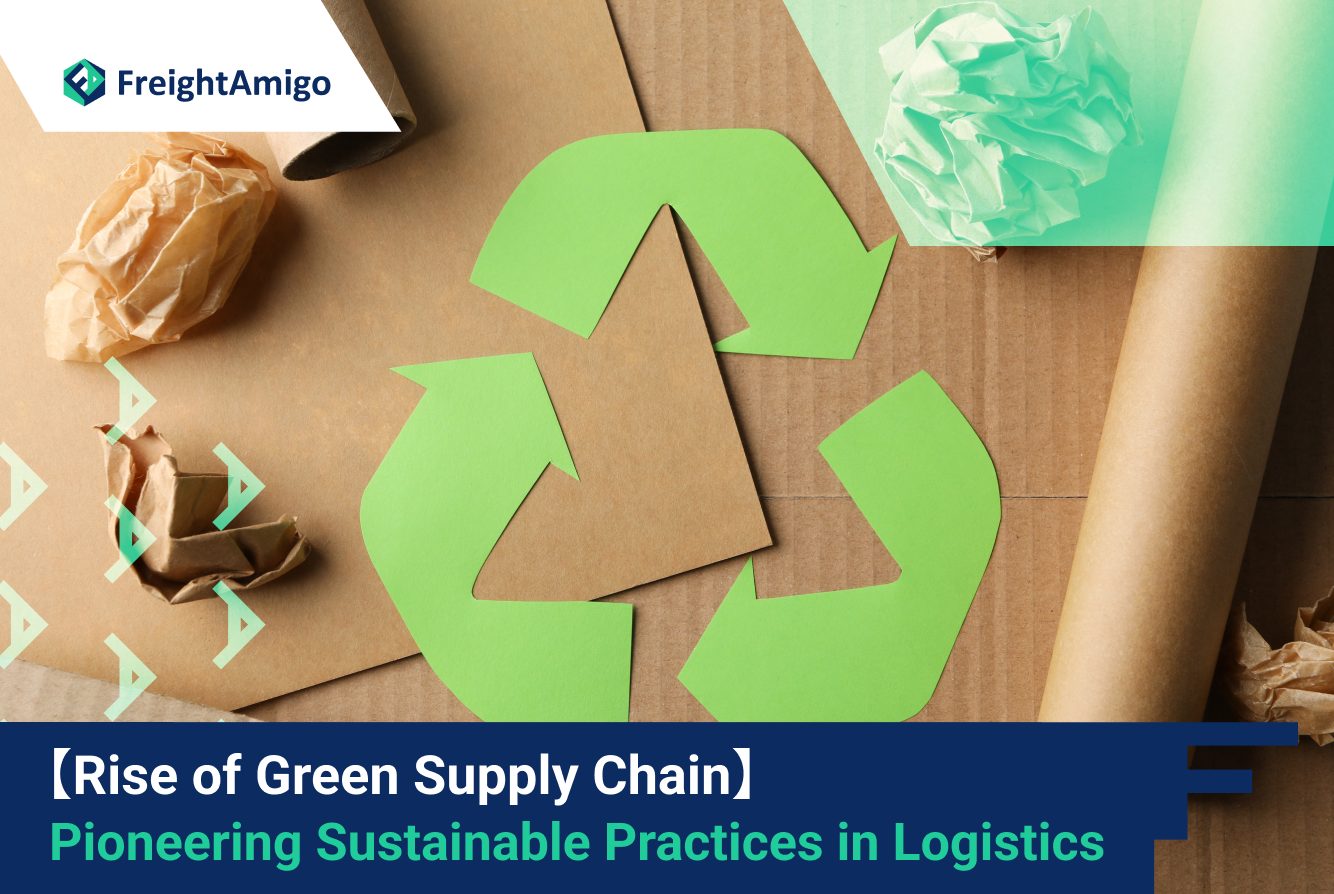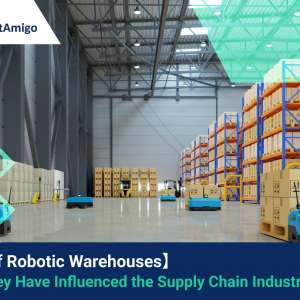Author Name: Tiffany Lee – Marketing Analyst at FreightAmigo
In recent years, the global community has witnessed the profound impact of various crises on the economy and the environment. From the Covid-19 pandemic to geopolitical conflicts and the escalating consequences of climate change, vulnerabilities within global supply chains have been exposed. As a result, policymakers and business leaders are reevaluating the resilience and sustainability of the international trading system. One avenue that has gained significant traction is the adoption of circular economy practices in supply chain management.
The circular economy is a systems solution framework based on three principles: eliminating waste and pollution, circulating products and materials at their highest value, and regenerating nature. By embracing these principles, companies can reduce their dependence on raw materials, enhance supply chain resilience, and contribute to a more sustainable future. Research has shown that businesses employing circular business models have experienced greater resilience during economic downturns, such as the Covid-19 pandemic.
In this article, we will explore the concept of the circular supply chain and its significance in driving sustainable practices in logistics. We will examine the benefits of adopting a circular economy approach, the intersection of circularity with trade negotiations, and the need for advancing circularity in international trade policies. Furthermore, we will delve into the strategies and initiatives that companies can employ to develop a green supply chain and become pioneers in sustainable logistics.
Want To Compare The Best Express, Air Freight, Sea Freight, Rail Freight & Trucking Rates So As To Have Better Control On Cost?
The Circular Supply Chain: Redefining Waste and Value
The traditional linear supply chain follows a “make, use, dispose” model, where products reach the end of their useful life and become waste. In contrast, the circular supply chain aims to eliminate waste and keep products and materials in use for as long as possible. It focuses on reusing, refurbishing, remanufacturing, and recycling products and their components, thereby extending their lifecycle and reducing environmental impact.
By implementing a circular supply chain, businesses can achieve several key benefits. Firstly, it helps to minimize resource consumption and waste generation, leading to cost savings in the long run. As materials become scarcer and more expensive, companies that embrace circularity can secure a reliable supply of resources and mitigate the risks associated with volatile commodity markets.
Secondly, a circular supply chain enables businesses to meet regulatory and certification standards related to sustainability. Many countries have implemented or are in the process of developing sustainable practices, and companies that demonstrate their commitment to circularity can gain a competitive advantage in the market. Certification programs, such as B Corp Certification, provide businesses with a recognized seal of approval for their sustainable supply chain practices.
Lastly, a circular supply chain appeals to environmentally-conscious consumers who prioritize sustainable and ethical practices. As consumer demand for eco-friendly products and services continues to grow, businesses that adopt circular practices can meet these expectations and differentiate themselves in the market. By promoting a circular supply chain, companies can enhance their brand reputation and attract a larger customer base.
The Intersection of Circular Economy and Trade Negotiations
Recognizing the potential of the circular economy to drive sustainable development, trade negotiators have begun incorporating circularity into trade agreements and policies. While initial efforts focused on waste minimization, there is a growing understanding of the broader positive impacts that a circular economy can have on trade, the environment, and society.
The World Trade Organization (WTO) has acknowledged the importance of the circular economy in achieving the United Nations Sustainable Development Goals (SDGs). Trade agreements have started to include provisions that support circular practices, such as remanufactured goods and the reduction of food waste. However, there is still a need for further integration of circular economy principles into trade-related policies.
To fully harness the potential of the circular economy in trade, it is essential to map its impacts across multiple policy areas and ensure alignment. This requires collaboration between international and national policymakers to identify the interconnections between trade, environment, labor, and other relevant policy domains. By considering the broader implications of circularity, trade agreements can foster sustainable and inclusive growth.
Advancing Circular Economy in Trade Policies
To advance the integration of circular economy principles into trade policies, several key areas need to be addressed. Firstly, there is a need for comprehensive mapping of the impacts of circular economy trade across various policy domains. This will ensure that trade policies align with circularity objectives and contribute to the achievement of the SDGs.
Investment in mechanisms that provide better information about goods through transparency and traceability is another crucial aspect. Governments and businesses must collaborate to develop systems that enable the disclosure and visibility of product information, including specifications, materials used, and production practices. Digital product passports and traceability protocols can facilitate responsible choices and improve supply chain transparency.
Furthermore, the scope of circular economy considerations should extend beyond trade in durable goods to encompass services and agricultural products. Services play a significant role in the global economy, and incorporating circularity into trade agreements can promote sustainable practices in areas such as design, maintenance, and digital services. Similarly, trade policies related to food and agriculture should nurture regenerative practices and incentivize the trade of lower-impact and upcycled ingredients.
Strategies for Developing a Green Supply Chain
Developing a green supply chain requires a holistic approach that encompasses various strategies and initiatives. Companies can adopt the following practices to pioneer sustainable logistics and establish themselves as leaders in the industry:
1.Design for Sustainability
Integrating sustainability principles into product design is a fundamental step in building a green supply chain. By considering environmental impact throughout the product lifecycle, businesses can create products that are easier to repair, refurbish, and recycle. Sustainable design practices include using recyclable or renewable materials, reducing energy consumption, and minimizing waste generation.
2.Reverse Logistics and Returns Management
Effective reverse logistics and returns management are essential components of a circular supply chain. Companies should implement processes to recover, refurbish, and resell returned products whenever possible. By optimizing reverse logistics operations, businesses can minimize waste, reduce costs, and enhance customer satisfaction.
3.Collaboration and Partnerships
Collaboration among supply chain stakeholders is critical for driving sustainable practices. Companies should establish partnerships with suppliers, customers, and other relevant organizations to foster knowledge sharing and innovation. Collaborative initiatives can include joint research and development projects, sharing best practices, and implementing shared logistics systems.
4.Transparency and Traceability
Transparency and traceability are key enablers of a green supply chain. Businesses should invest in technologies and systems that provide visibility into the entire supply chain, from raw material sourcing to end-of-life disposal. This enables companies to track and monitor their environmental impact, identify areas for improvement, and communicate their sustainability efforts to stakeholders.
5.Supplier Engagement and Auditing
Engaging suppliers in sustainable practices is crucial for building a green supply chain. Companies should establish clear sustainability criteria and conduct regular audits to ensure compliance. Supplier engagement programs can include capacity building, training, and incentivizing sustainable practices.
6.Circular Packaging Solutions
Packaging plays a significant role in the environmental impact of supply chains. Companies should explore circular packaging solutions, such as using recyclable or biodegradable materials, optimizing packaging design to reduce waste, and implementing take-back programs for packaging materials. By adopting sustainable packaging practices, businesses can minimize their carbon footprint and contribute to a circular economy.
7.Renewable Energy Adoption
Transitioning to renewable energy sources is another essential aspect of a green supply chain. Companies should invest in renewable energy infrastructure, such as solar panels and wind turbines, to power their operations. By reducing reliance on fossil fuels, businesses can lower their carbon emissions and contribute to a cleaner and more sustainable energy system.
8.Lifecycle Assessments and Environmental Impact Reduction
Conducting lifecycle assessments of products and supply chain operations can help identify areas for environmental impact reduction. Companies should analyze the entire lifecycle of their products, from raw material extraction to disposal, and implement measures to minimize resource consumption, waste generation, and emissions. Continuous improvement and innovation should be prioritized to achieve long-term sustainability goals.
9.Collaboration with Non-Governmental Organizations (NGOs) and Regulatory Bodies
Collaborating with NGOs and regulatory bodies can provide valuable guidance and support in developing a green supply chain. Companies should actively engage with organizations focused on sustainability and compliance to stay informed about emerging regulations, industry best practices, and technological advancements. These partnerships can help drive innovation and ensure alignment with global sustainability standards.
10.Continuous Improvement and Innovation
A green supply chain is an ongoing journey of continuous improvement and innovation. Companies should establish mechanisms for monitoring and evaluating their sustainability performance, set ambitious targets, and regularly review and update their strategies. By fostering a culture of sustainability and embracing innovation, businesses can stay ahead of evolving customer expectations and market trends.
Conclusion
The rise of the green supply chain represents a paradigm shift in logistics, where sustainability and circularity are at the forefront of business strategies. By adopting circular economy practices, companies can reduce waste, enhance resource efficiency, and contribute to a more resilient and sustainable global trading system. The integration of circularity into trade policies and agreements is crucial for driving widespread adoption of green supply chain practices.
As businesses strive to develop a green supply chain, they must embrace strategies such as sustainable design, reverse logistics, collaboration, transparency, renewable energy adoption, and continuous improvement. By pioneering sustainable logistics, companies can differentiate themselves in the market, attract environmentally-conscious consumers, and contribute to a more sustainable future.
The journey towards a green supply chain requires collective action, collaboration, and a commitment to long-term sustainability. As companies lead the way in adopting circular economy practices, they can inspire others to follow suit, creating a positive ripple effect throughout global supply chains. By working together, we can build a more resilient, efficient, and sustainable logistics ecosystem that benefits both businesses and the planet.
There Are Different Options For Cargo Transportation. If You Want To Choose The Most Convenient And Suitable Solution, It Is Best To Have The Full Support Of Logistics Experts! If You Are Planning To Ship Goods Overseas, Please Go To The FreightAmigo Page For Inquiries.
===
Read More:
【Low-Carbon Logistics】 The Future of Last-Mile Delivery
【The Power of Collaboration】 Achieving ESG Goals in Logistics
【Embracing Renewable Energy】 A Green Shift in Logistics
===
If you have any inquiries on logistics/supply chain, feel free to contact FreightAmigo now:
Chat with us online OR
Phone : +852 28121686
WhatsApp: +852 27467829









































